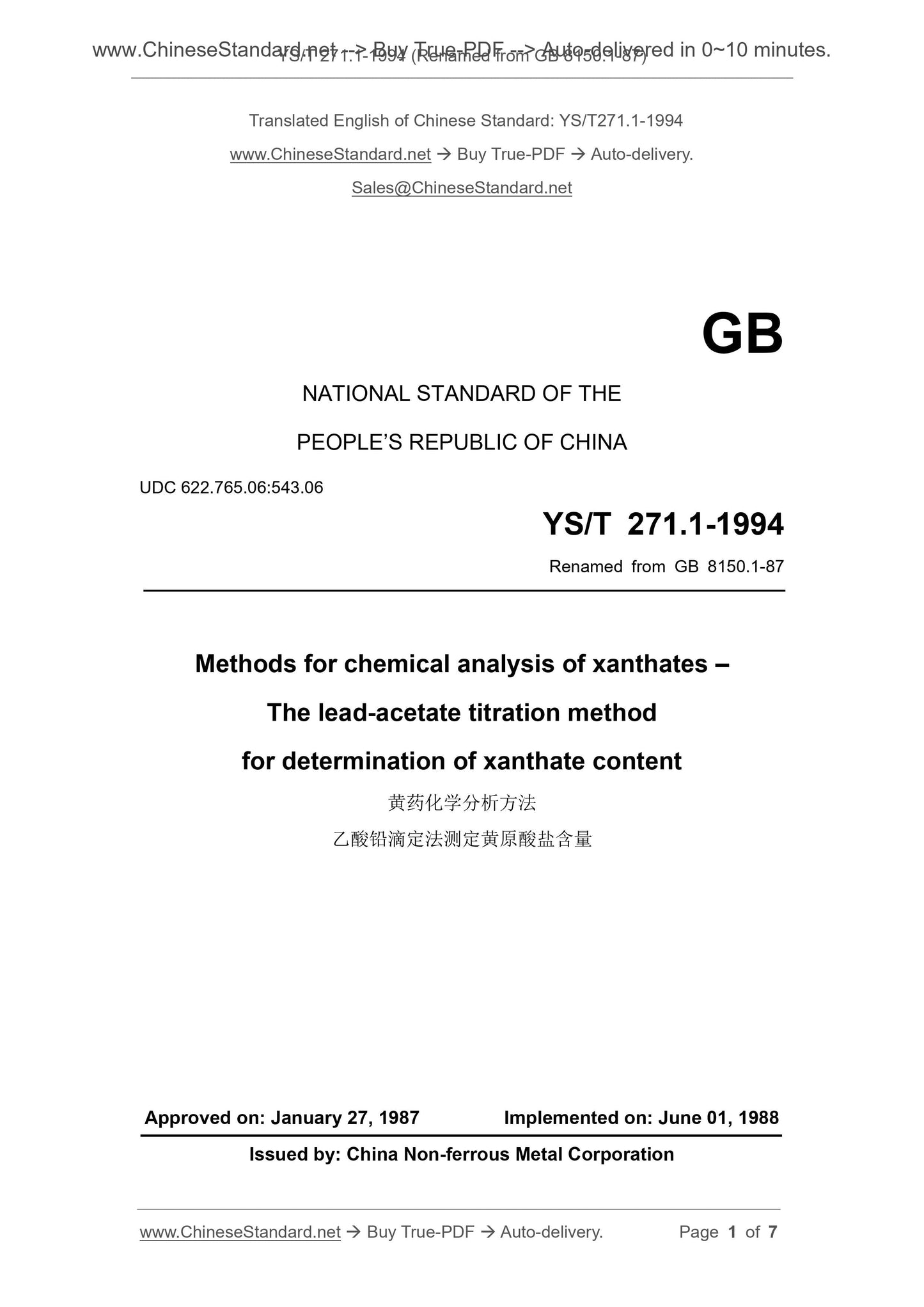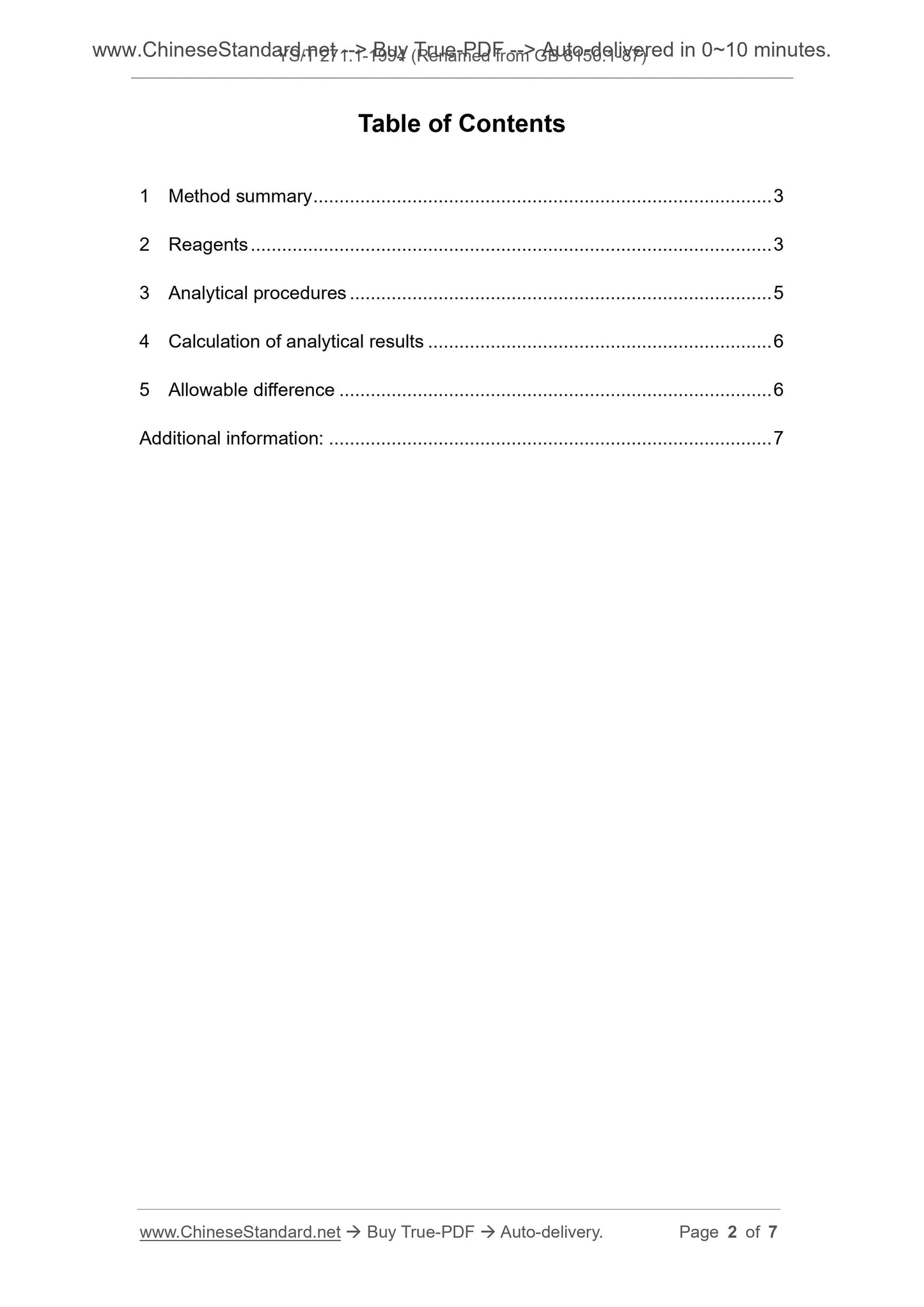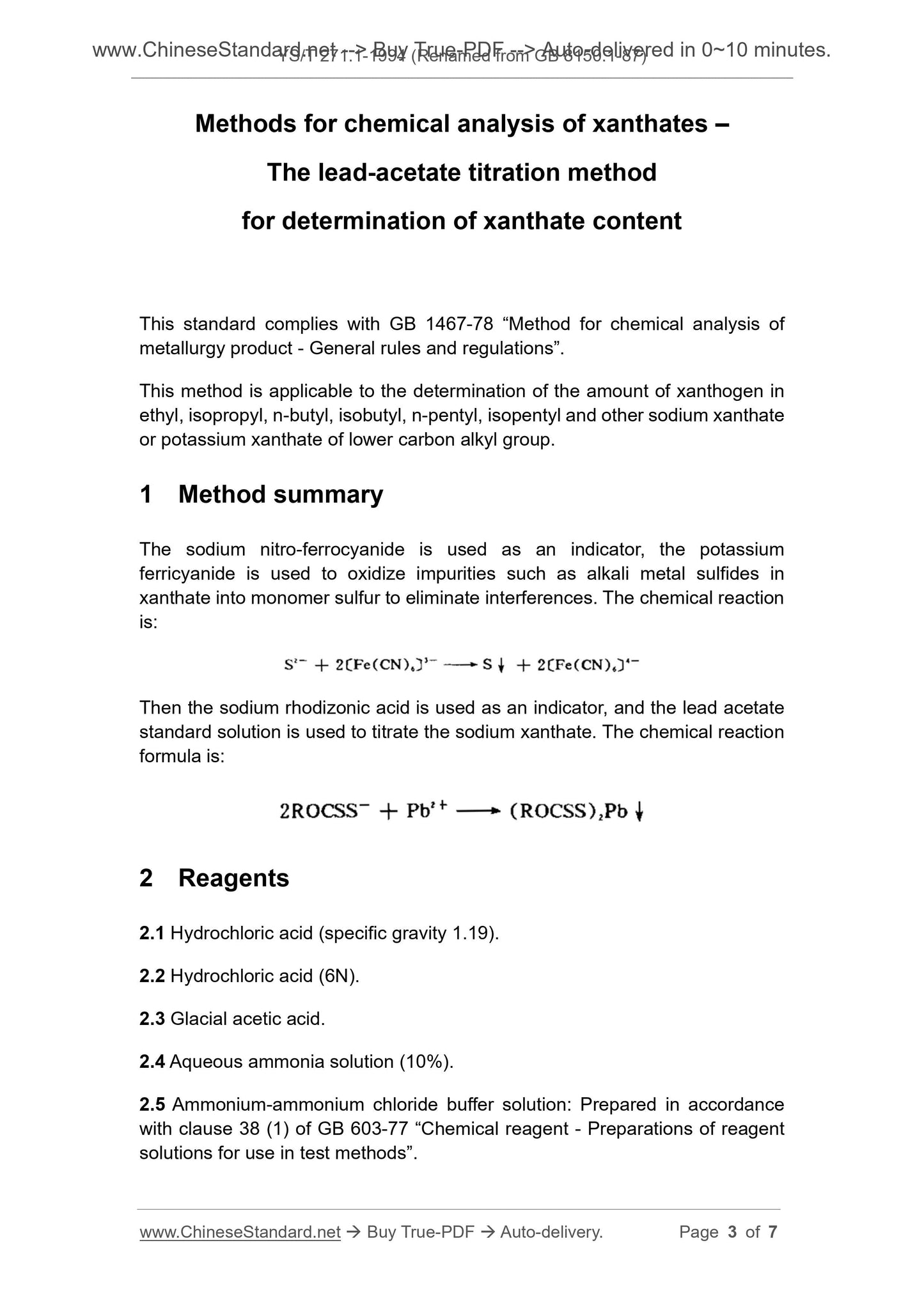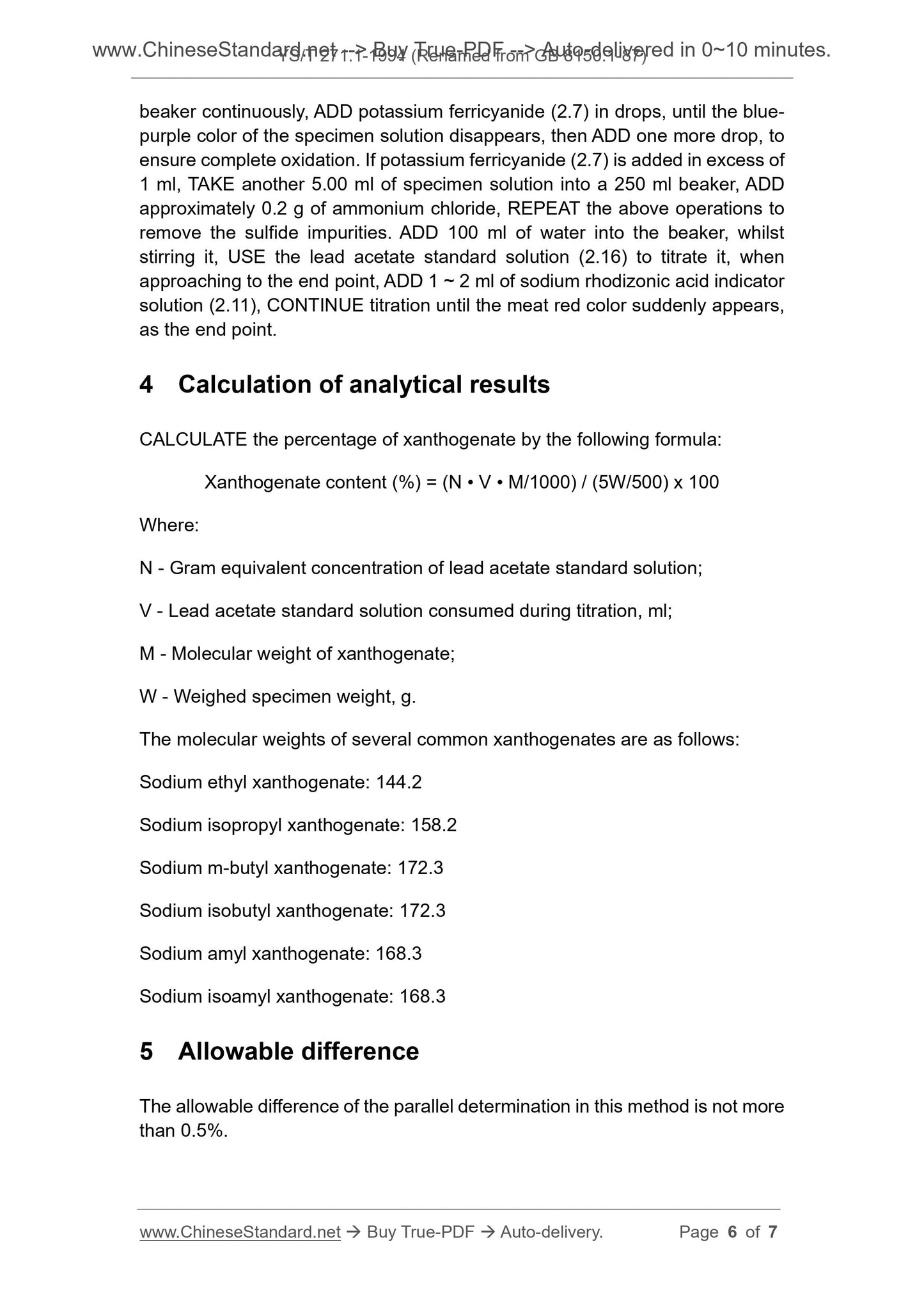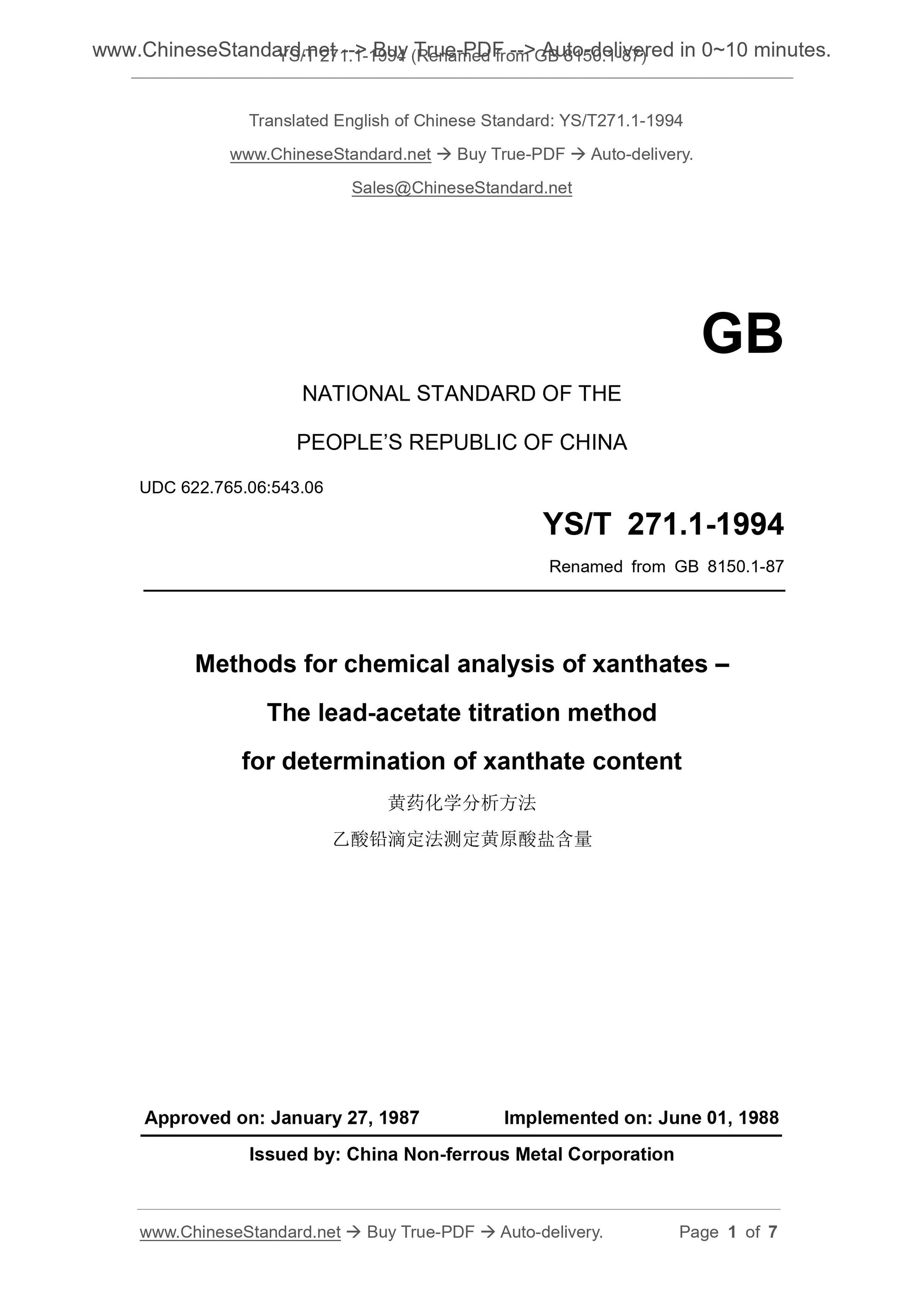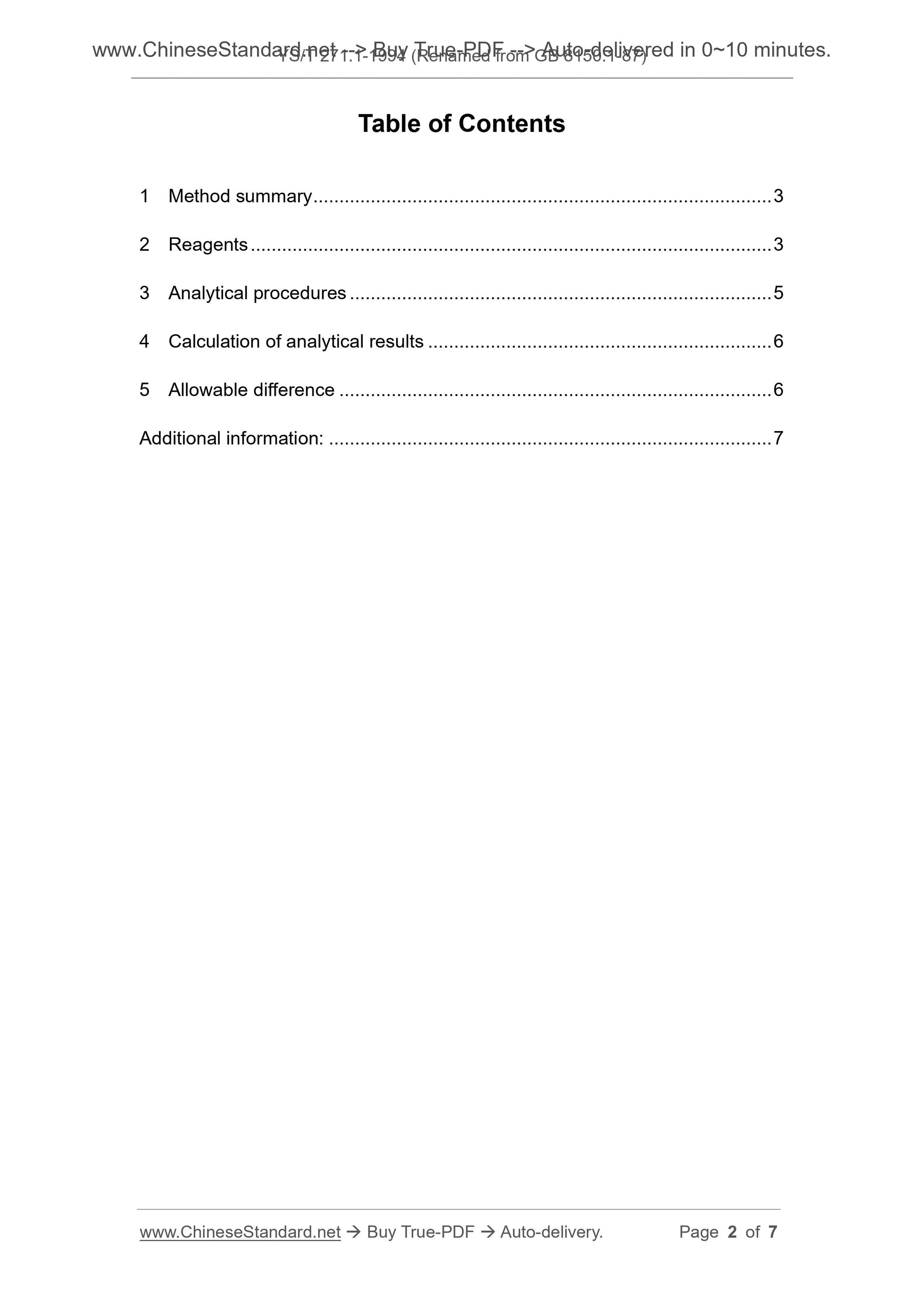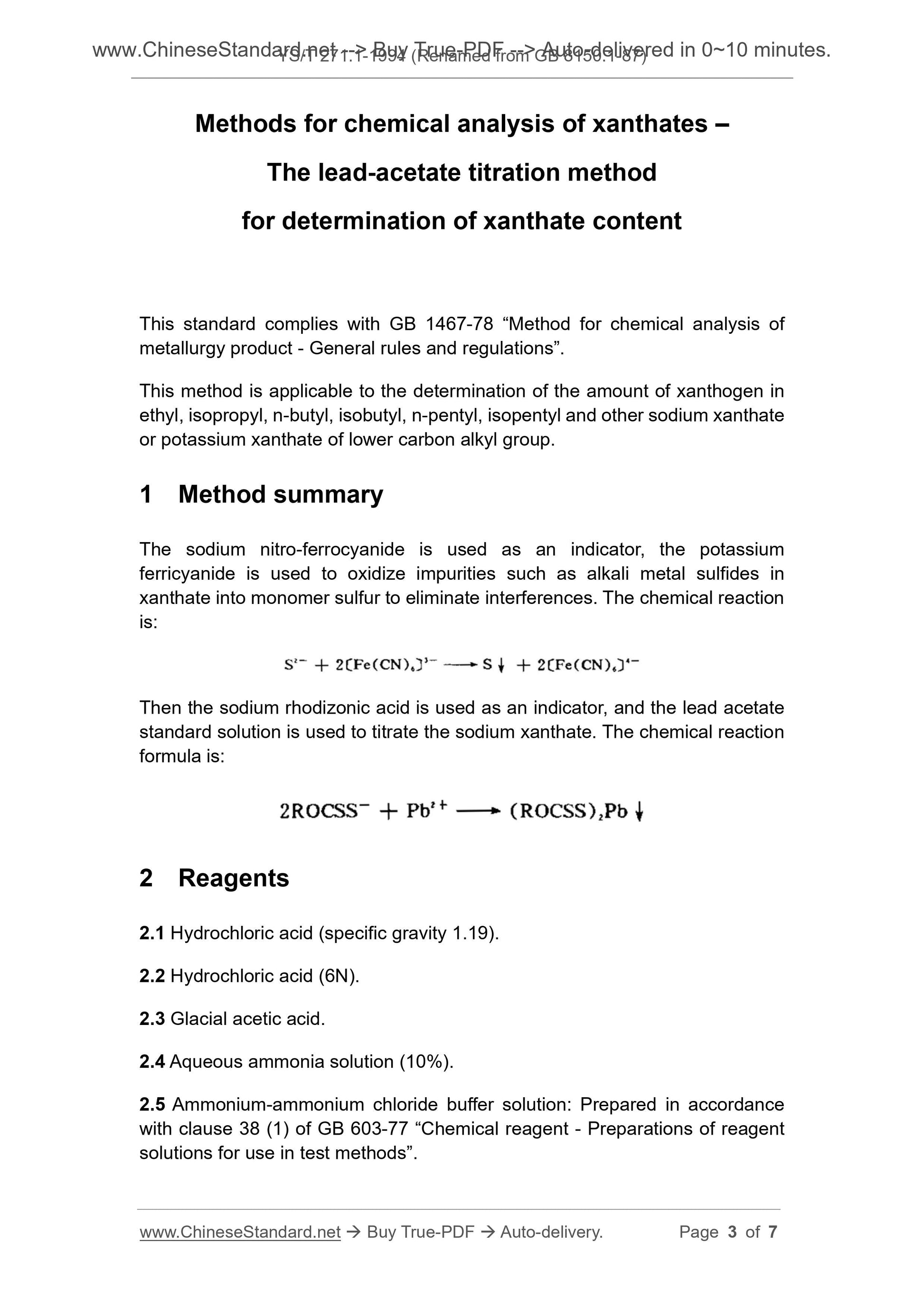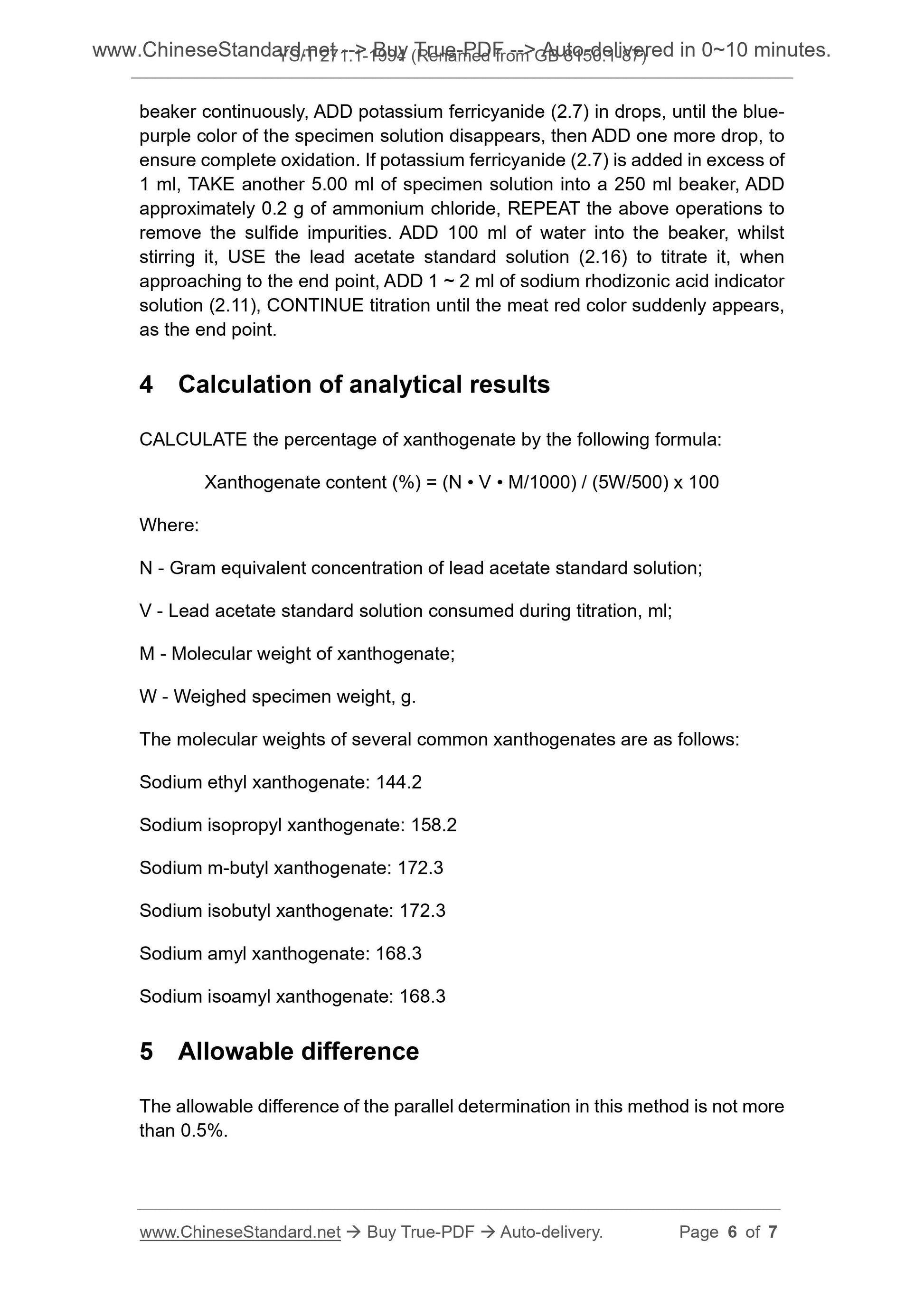1
/
of
4
PayPal, credit cards. Download editable-PDF and invoice in 1 second!
YS/T 271.1-1994 English PDF (YST271.1-1994)
YS/T 271.1-1994 English PDF (YST271.1-1994)
Regular price
$95.00 USD
Regular price
Sale price
$95.00 USD
Unit price
/
per
Shipping calculated at checkout.
Couldn't load pickup availability
Delivery: 3 seconds. Download true-PDF + Invoice.
Get QUOTATION in 1-minute: Click YS/T 271.1-1994
Historical versions: YS/T 271.1-1994
Preview True-PDF (Reload/Scroll if blank)
YS/T 271.1-1994: Methods for chemical analysis of xanthates. The lead-acetate titration method for determination of xanthate content
YS/T 271.1-1994 (Renamed from GB 8150.1-87)
GB
NATIONAL STANDARD OF THE
PEOPLE’S REPUBLIC OF CHINA
UDC 622.765.06.543.06
YS/T 271.1-1994
Renamed from GB 8150.1-87
Methods for chemical analysis of xanthates –
The lead-acetate titration method
for determination of xanthate content
APPROVED ON. JANUARY 27, 1987
IMPLEMENTED ON. JUNE 01, 1988
Issued by. China Non-ferrous Metal Corporation
Table of Contents
1 Method summary ... 3
2 Reagents ... 3
3 Analytical procedures ... 5
4 Calculation of analytical results ... 6
5 Allowable difference ... 6
Additional information... 7
Methods for chemical analysis of xanthates –
The lead-acetate titration method
for determination of xanthate content
This standard complies with GB 1467-78 “Method for chemical analysis of
metallurgy product - General rules and regulations”.
This method is applicable to the determination of the amount of xanthogen in
ethyl, isopropyl, n-butyl, isobutyl, n-pentyl, isopentyl and other sodium xanthate
or potassium xanthate of lower carbon alkyl group.
1 Method summary
The sodium nitro-ferrocyanide is used as an indicator, the potassium
ferricyanide is used to oxidize impurities such as alkali metal sulfides in
xanthate into monomer sulfur to eliminate interferences. The chemical reaction
is.
Then the sodium rhodizonic acid is used as an indicator, and the lead acetate
standard solution is used to titrate the sodium xanthate. The chemical reaction
formula is.
2 Reagents
2.1 Hydrochloric acid (specific gravity 1.19).
2.2 Hydrochloric acid (6N).
2.3 Glacial acetic acid.
2.4 Aqueous ammonia solution (10%).
2.5 Ammonium-ammonium chloride buffer solution. Prepared in accordance
with clause 38 (1) of GB 603-77 “Chemical reagent - Preparations of reagent
solutions for use in test methods”.
beaker continuously, ADD potassium ferricyanide (2.7) in drops, until the blue-
purple color of the specimen solution disappears, then ADD one more drop, to
ensure complete oxidation. If potassium ferricyanide (2.7) is added in excess of
1 ml, TAKE another 5.00 ml of specimen solution into a 250 ml beaker, ADD
approximately 0.2 g of ammonium chloride, REPEAT the above operations to
remove the sulfide impurities. ADD 100 ml of water into the beaker, whilst
stirring it, USE the lead acetate standard solution (2.16) to titrate it, when
approaching to the end point, ADD 1 ~ 2 ml of sodium rhodizonic acid indicator
solution (2.11), CONTINUE titration until the meat red color suddenly appears,
as the end point.
4 Calculation of analytical results
CALCULATE the percentage of xanthogenate by the following formula.
Xanthogenate content (%) = (N • V • M/1000)/(5W/500) x 100
Where.
N - Gram equivalent concentration of lead acetate standard solution;
V - Lead acetate standard solution consumed during titration, ml;
M - Molecular weight of xanthogenate;
W - Weighed specimen weight, g.
The molecular weights of several common xanthogenates are as follows.
Sodium ethyl xanthogenate. 144.2
Sodium isopropyl xanthogenate. 158.2
Sodium m-butyl xanthogenate. 172.3
Sodium isobutyl xanthogenate. 172.3
Sodium amyl xanthogenate. 168.3
Sodium isoamyl xanthogenate. 168.3
5 Allowable difference
The allowable difference of the parallel determination in this method is not more
than 0.5%.
Get QUOTATION in 1-minute: Click YS/T 271.1-1994
Historical versions: YS/T 271.1-1994
Preview True-PDF (Reload/Scroll if blank)
YS/T 271.1-1994: Methods for chemical analysis of xanthates. The lead-acetate titration method for determination of xanthate content
YS/T 271.1-1994 (Renamed from GB 8150.1-87)
GB
NATIONAL STANDARD OF THE
PEOPLE’S REPUBLIC OF CHINA
UDC 622.765.06.543.06
YS/T 271.1-1994
Renamed from GB 8150.1-87
Methods for chemical analysis of xanthates –
The lead-acetate titration method
for determination of xanthate content
APPROVED ON. JANUARY 27, 1987
IMPLEMENTED ON. JUNE 01, 1988
Issued by. China Non-ferrous Metal Corporation
Table of Contents
1 Method summary ... 3
2 Reagents ... 3
3 Analytical procedures ... 5
4 Calculation of analytical results ... 6
5 Allowable difference ... 6
Additional information... 7
Methods for chemical analysis of xanthates –
The lead-acetate titration method
for determination of xanthate content
This standard complies with GB 1467-78 “Method for chemical analysis of
metallurgy product - General rules and regulations”.
This method is applicable to the determination of the amount of xanthogen in
ethyl, isopropyl, n-butyl, isobutyl, n-pentyl, isopentyl and other sodium xanthate
or potassium xanthate of lower carbon alkyl group.
1 Method summary
The sodium nitro-ferrocyanide is used as an indicator, the potassium
ferricyanide is used to oxidize impurities such as alkali metal sulfides in
xanthate into monomer sulfur to eliminate interferences. The chemical reaction
is.
Then the sodium rhodizonic acid is used as an indicator, and the lead acetate
standard solution is used to titrate the sodium xanthate. The chemical reaction
formula is.
2 Reagents
2.1 Hydrochloric acid (specific gravity 1.19).
2.2 Hydrochloric acid (6N).
2.3 Glacial acetic acid.
2.4 Aqueous ammonia solution (10%).
2.5 Ammonium-ammonium chloride buffer solution. Prepared in accordance
with clause 38 (1) of GB 603-77 “Chemical reagent - Preparations of reagent
solutions for use in test methods”.
beaker continuously, ADD potassium ferricyanide (2.7) in drops, until the blue-
purple color of the specimen solution disappears, then ADD one more drop, to
ensure complete oxidation. If potassium ferricyanide (2.7) is added in excess of
1 ml, TAKE another 5.00 ml of specimen solution into a 250 ml beaker, ADD
approximately 0.2 g of ammonium chloride, REPEAT the above operations to
remove the sulfide impurities. ADD 100 ml of water into the beaker, whilst
stirring it, USE the lead acetate standard solution (2.16) to titrate it, when
approaching to the end point, ADD 1 ~ 2 ml of sodium rhodizonic acid indicator
solution (2.11), CONTINUE titration until the meat red color suddenly appears,
as the end point.
4 Calculation of analytical results
CALCULATE the percentage of xanthogenate by the following formula.
Xanthogenate content (%) = (N • V • M/1000)/(5W/500) x 100
Where.
N - Gram equivalent concentration of lead acetate standard solution;
V - Lead acetate standard solution consumed during titration, ml;
M - Molecular weight of xanthogenate;
W - Weighed specimen weight, g.
The molecular weights of several common xanthogenates are as follows.
Sodium ethyl xanthogenate. 144.2
Sodium isopropyl xanthogenate. 158.2
Sodium m-butyl xanthogenate. 172.3
Sodium isobutyl xanthogenate. 172.3
Sodium amyl xanthogenate. 168.3
Sodium isoamyl xanthogenate. 168.3
5 Allowable difference
The allowable difference of the parallel determination in this method is not more
than 0.5%.
Share
